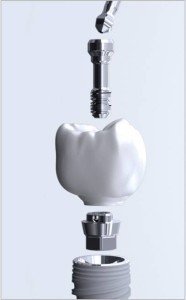
Robotic-Guided Dental Implant Placement in Fully Edentulous Patients
Preliminary Results of a Prospective Multi-Center Clinical Study
Digital workflows have improved dental implant placement accuracy and precision in fully edentulous patients with a goal of predictable restorations. Despite the introduction of CBCT-based planning software and fabricated surgical guides, challenges remain in efficiently and accurately transferring the plans at surgery. Limitations inherent in the static guide workflow include treatment delays related to guide fabrication, the risk of poorly fitting guides, and the physical bulk of the guide impeding surgical site access and visualization. Robotic guidance using haptic boundaries has been well-documented to enhance accuracy, precision, and flexibility across surgical fields.1 Recently, robotic haptic guidance with the novel Yomi platform (Neocis Inc., Miami, FL) has shown promise in partially edentulous patients.2 This study aimed to evaluate the platform in fully edentulous patients. In a preliminary subset of a prospective single-arm clinical study, 8 patients who qualified for and elected to have dental implants to restore full-arch dentition were treated using Yomi robotic guidance. A virtual preoperative restorative and surgical plan was created on Yomi Plan software (Neocis Inc., Miami, FL) prior to surgery. On the day of surgery, the Yomi edentulous patient splint was affixed to the anterior maxilla or mandible using self-tapping bone screws. A patient CBCT scan with a splint-mounted fiducial array was obtained and merged with the previously created virtual plan. The fiducial array was replaced with a patient tracker end effector allowing Yomi to track patient motion. Intraoperatively, the surgeons maneuvered a handpiece attached to the Yomi robotic guidance arm, which haptically constrained osteotomies and implant placement to the virtual plan. Splint affixation proceeded under local anesthesia and the implant procedure under either local or general anesthesia. Intraoperative outcomes captured included safety, efficacy, surgical time, and a Likert scale evaluation of user experience. A total of 58 implants were placed in 11 arches in 8 patients. Thirty-five implants were placed in the mandible and 23 in the maxilla, including 3 dual-arch cases. Eight patients were edentulated during surgery. Bone quality ranged from poor to very dense. Yomi edentulous patient splint affixation and removal times averaged 6.5 ± 3.9 and 1.1 ± 0.3 minutes, respectively. Surgical time per arch averaged 20.5 ± 10.3 minutes for osteotomies and 9.9 ± 7.9 minutes for implant placement. Three arches were considered candidates for and were treated using a flapless approach, and conservative tissue flaps were performed in all other cases. Two patients had been considered candidates for and were successfully provided with immediately loaded full-arch prostheses. No adverse events were reported, and user experience was rated highly with respect to the standard of care. First cases using Yomi robotic guidance in fully edentulous patients were notable for brief procedural times, compatibility with minimally invasive soft tissue management and access to immediate loading of restorations for candidate patients. These results may attest to quick integration of the Yomi edentulous protocol into the digital practitioner’s clinical workflow and the ease of employing robotic guidance to enhance edentulous patient treatment. Additionally, there was no wait for surgical guide fabrication and no physical guide impeding access or visualization. Robotic haptic guidance securely constrained the handpiece to the virtual restorative plan. Given the accuracy, precision, and intraoperative flexibility of robotic surgical platforms, these preliminary data support the promise of Yomi robotic guidance to augment dental implant therapy for fully edentulous arches. This study was approved by WIRB and the FDA as G190282 Edentulous Patient Splint.
Figure thumbnail fx1
The Yomi edentulous patient splint was affixed anterior to the maxilla or mandible using self-tapping bone screws and intraoperatively connected to a patient tracker end effector, allowing the robotic system to track patient motion.
Figure thumbnail fx2
The surgeons maneuvered a handpiece attached to the Yomi robotic guidance arm, which haptically constrained motion to the virtual plan. Full-arch osteotomies and dental implant placement proceeded under haptic guidance.
Figure thumbnail fx3
Two patients had been considered candidates for and were successfully provided with immediately loaded full-arch prostheses. Successful early incorporation of immediately loaded prostheses indicates the ease with which robotic guidance may be employed to enhance restorative-driven protocols.




